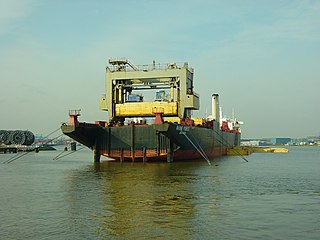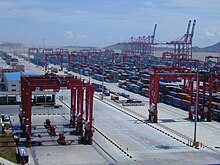
A crane is a type of machine, generally equipped with a hoist rope, wire ropes or chains, and sheaves, that can be used both to lift and lower materials and to move them horizontally. It is mainly used for lifting heavy objects and transporting them to other places. The device uses one or more simple machines to create mechanical advantage and thus move loads beyond the normal capability of a human. Cranes are commonly employed in transportation for the loading and unloading of freight, in construction for the movement of materials, and in manufacturing for the assembling of heavy equipment.

Intermodal freight transport involves the transportation of freight in an intermodal container or vehicle, using multiple modes of transportation, without any handling of the freight itself when changing modes. The method reduces cargo handling, and so improves security, reduces damage and loss, and allows freight to be transported faster. Reduced costs over road trucking is the key benefit for inter-continental use. This may be offset by reduced timings for road transport over shorter distances.

A sidelifter is a specialised vehicle or semi-trailer used to hoist and transport ISO standard intermodal containers over longer distances.

A container crane is a type of large dockside gantry crane found at container terminals for loading and unloading intermodal containers from container ships.

The lighter aboard ship (LASH) system refers to the practice of loading barges (lighters) aboard a bigger vessel for transport. It was developed in response to a need to transport lighters, a type of unpowered barge, between inland waterways separated by open seas. Lighters are typically towed or pushed around harbors, canals or rivers and cannot be relocated under their own power. The carrier ships are known variously as LASH carriers, barge carriers, kangaroo ships or lighter transport ships.

Belfast Harbour is a major maritime hub in Belfast, Northern Ireland, handling 67% of Northern Ireland's seaborne trade and about 25% of the maritime trade of the entire island of Ireland. It is a vital gateway for raw materials, exports and consumer goods, and is also Northern Ireland's leading logistics and distribution hub.

An overhead crane, commonly called a bridge crane, is a type of crane found in industrial environments. An overhead crane consists of two parallel rails seated on longitudinal I-beams attached to opposite steel columns by means of brackets. The traveling bridge spans the gap. A hoist, the lifting component of a crane, travels along the bridge. If the bridge is rigidly supported on two or more legs running on two fixed rails at ground level, the crane is called a gantry crane or a goliath crane.

A linkspan or link-span is a type of drawbridge used mainly in the operation of moving vehicles on and off a roll-on/roll-off (RO-RO) vessel or ferry, particularly to allow for tidal changes in water level.

A crane vessel, crane ship, crane barge, or floating crane is a ship with a crane specialized in lifting heavy loads, typically exceeding 1,500 t for modern ships. The largest crane vessels are used for offshore construction.

A straddle carrier or straddle truck is a freight-carrying vehicle that carries its load underneath by "straddling" it, rather than carrying it on top like a conventional truck. The advantage of the straddle carrier is its ability to load and unload without the assistance of cranes or forklifts. The lifting apparatus under the carrier is operated by the driver without any outside assistance and without leaving the driver's seat.

The Port of Haydarpaşa, also known as the Port of Haidar Pasha or the Port of Istanbul, is a general cargo seaport, ro-ro and container terminal, situated in Haydarpaşa, Istanbul, Turkey at the southern entrance to the Bosphorus, near Haydarpaşa Station. It is operated by the Turkish State Railways (TCDD) and serves a hinterland which includes the country's most industrialised areas.

A rubber tyred gantry crane / RTG (crane), or sometimes transtainer, is a wheeled mobile gantry crane operated to ground or stack intermodal containers. Inbound containers are stored for future pickup by drayage trucks, and outbound are stored for future loading onto vessels. RTGs typically straddle multiple lanes, with one lane reserved for container transfers. Advantages:its mobility gives a rubber tyred gantry crane wide appliance

Great Yarmouth Outer Harbour is a port constructed on the east coast of England at Great Yarmouth. Construction work on the Outer Harbour began in June 2007. The harbour which is built in the South Denes area was planned to bring trade to the area. The plans included a container terminal and a passenger ferry terminal, but with no confirmed contracts these were not built.

Pioneering Spirit is a catamaran crane vessel owned by the Switzerland-based Allseas Group designed for the single-lift installation and removal of large oil and gas platforms and the installation of record-weight pipelines. The 382-metre-long (1,253 ft), 124-metre-wide (407 ft) vessel is the world's largest vessel by gross tonnage, and since September 2021 also the largest floating sheerleg in the world. It was built in South Korea by Daewoo Shipbuilding & Marine Engineering in 2013 at a cost of €2.6 billion. It commenced offshore operations in August 2016.

Taisun is the world's strongest crane, having a safe working load of 20,000 metric tons. Taisun is designed by DHHI and built for the installation of very large modules in semi submersibles and FPSO projects. It is located at Yantai Raffles Shipyard in Yantai, Shandong Province, China. The crane holds the three heaviest lifts of all time respectively: 20,133 metric tons, 17,100 tons and 14,000 tons.
A berth is a designated location in a port or harbour used for mooring vessels when they are not at sea. Berths provide a vertical front which allows safe and secure mooring that can then facilitate the unloading or loading of cargo or people from vessels.
A cellular vessel is a container ship specially designed for the efficient storage of freight containers one on top of other with vertical bracings at the four corners. The majority of vessels operated by maritime carriers are fully cellular ships.

Lekki Deep Sea Port, operational, but still partly under construction, is a multi-purpose, deep sea port in the Lagos Free Zone.

A travel lift or travelift is a specialised type of crane used for lifting boats out of the water and transporting them around docks or marinas. These cranes allow boats with masts or tall superstructure to be transported around hard stands as the tall upper structure can pass through the open end of the crane framework before lifting and after setting down.

Tibar Bay Port is a container seaport at Tibar Bay, near Dili, the capital city of East Timor. The largest item of infrastructure in East Timor, and in the country's history, it commenced operations on 30 September 2022.
























